2015 NISSAN LEAF warning light
[x] Cancel search: warning lightPage 355 of 412
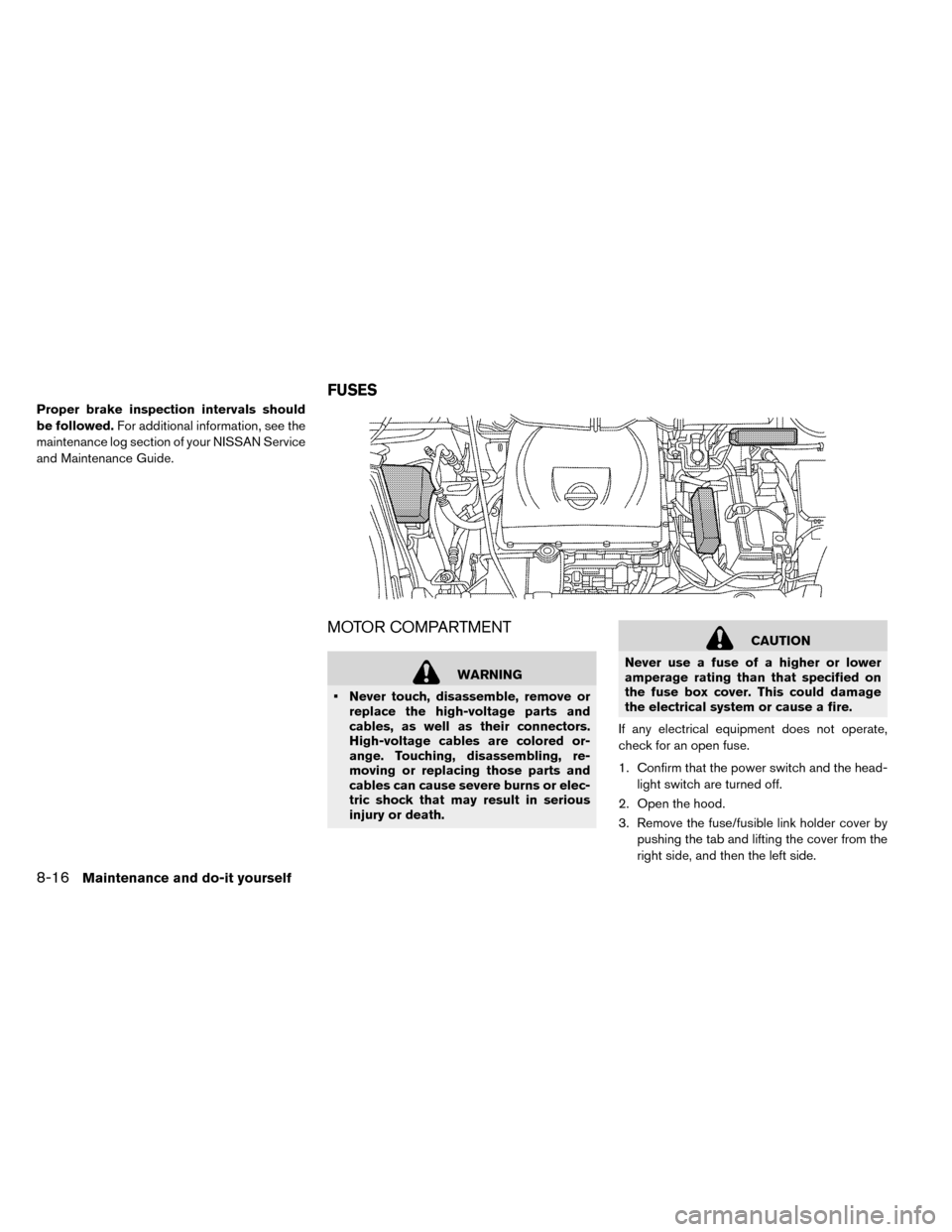
Proper brake inspection intervals should
be followed.For additional information, see the
maintenance log section of your NISSAN Service
and Maintenance Guide.
MOTOR COMPARTMENT
WARNING
• Never touch, disassemble, remove or replace the high-voltage parts and
cables, as well as their connectors.
High-voltage cables are colored or-
ange. Touching, disassembling, re-
moving or replacing those parts and
cables can cause severe burns or elec-
tric shock that may result in serious
injury or death.
CAUTION
Never use a fuse of a higher or lower
amperage rating than that specified on
the fuse box cover. This could damage
the electrical system or cause a fire.
If any electrical equipment does not operate,
check for an open fuse.
1. Confirm that the power switch and the head- light switch are turned off.
2. Open the hood.
3. Remove the fuse/fusible link holder cover by pushing the tab and lifting the cover from the
right side, and then the left side.
FUSES
8-16Maintenance and do-it yourself
Page 365 of 412
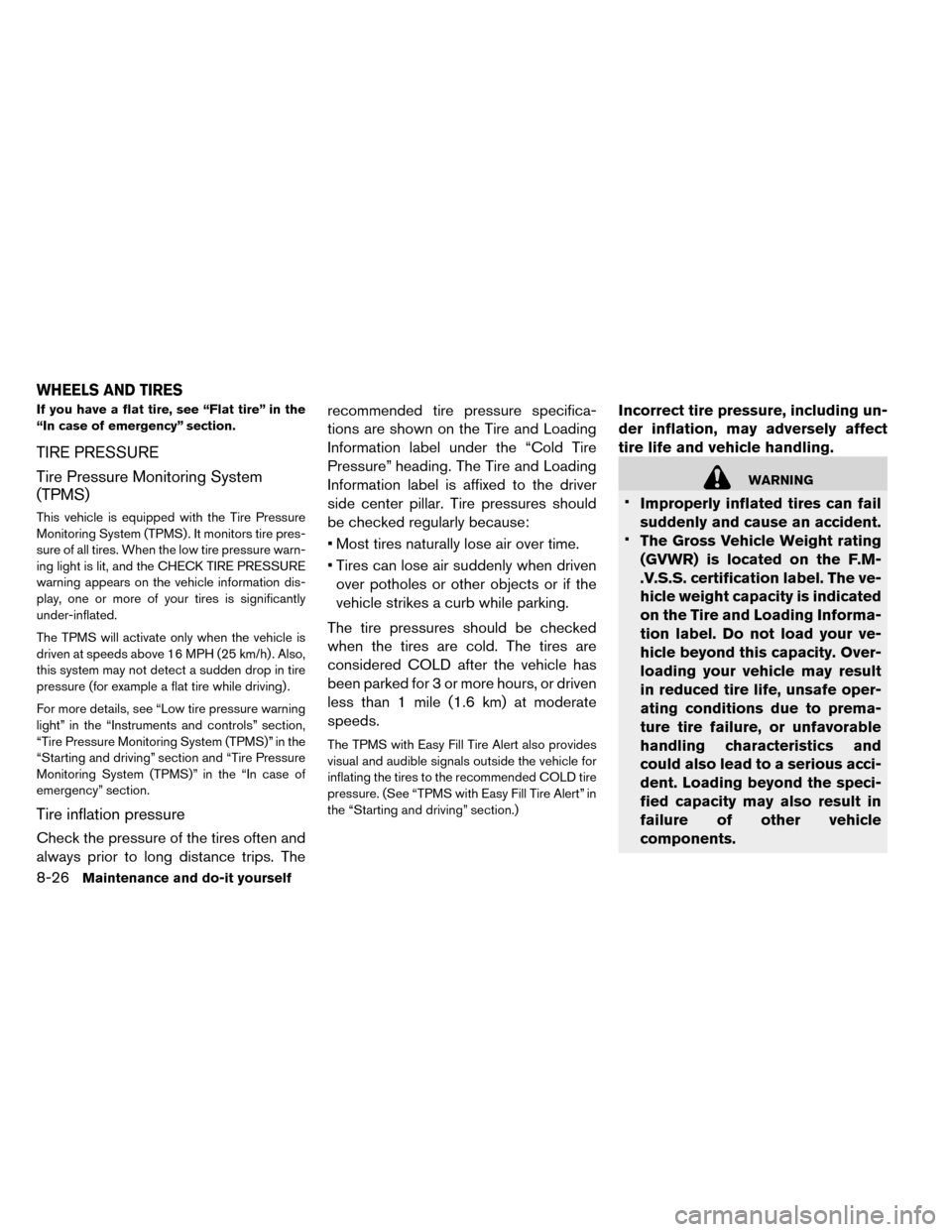
If you have a flat tire, see “Flat tire” in the
“In case of emergency” section.
TIRE PRESSURE
Tire Pressure Monitoring System
(TPMS)
This vehicle is equipped with the Tire Pressure
Monitoring System (TPMS) . It monitors tire pres-
sure of all tires. When the low tire pressure warn-
ing light is lit, and the CHECK TIRE PRESSURE
warning appears on the vehicle information dis-
play, one or more of your tires is significantly
under-inflated.
The TPMS will activate only when the vehicle is
driven at speeds above 16 MPH (25 km/h) . Also,
this system may not detect a sudden drop in tire
pressure (for example a flat tire while driving) .
For more details, see “Low tire pressure warning
light” in the “Instruments and controls” section,
“Tire Pressure Monitoring System (TPMS)” in the
“Starting and driving” section and “Tire Pressure
Monitoring System (TPMS)” in the “In case of
emergency” section.
Tire inflation pressure
Check the pressure of the tires often and
always prior to long distance trips. Therecommended tire pressure specifica-
tions are shown on the Tire and Loading
Information label under the “Cold Tire
Pressure” heading. The Tire and Loading
Information label is affixed to the driver
side center pillar. Tire pressures should
be checked regularly because:
• Most tires naturally lose air over time.
• Tires can lose air suddenly when driven
over potholes or other objects or if the
vehicle strikes a curb while parking.
The tire pressures should be checked
when the tires are cold. The tires are
considered COLD after the vehicle has
been parked for 3 or more hours, or driven
less than 1 mile (1.6 km) at moderate
speeds.
The TPMS with Easy Fill Tire Alert also provides
visual and audible signals outside the vehicle for
inflating the tires to the recommended COLD tire
pressure. (See “TPMS with Easy Fill Tire Alert” in
the “Starting and driving” section.)
Incorrect tire pressure, including un-
der inflation, may adversely affect
tire life and vehicle handling.
WARNING
•
Improperly inflated tires can fail
suddenly and cause an accident.
•The Gross Vehicle Weight rating
(GVWR) is located on the F.M-
.V.S.S. certification label. The ve-
hicle weight capacity is indicated
on the Tire and Loading Informa-
tion label. Do not load your ve-
hicle beyond this capacity. Over-
loading your vehicle may result
in reduced tire life, unsafe oper-
ating conditions due to prema-
ture tire failure, or unfavorable
handling characteristics and
could also lead to a serious acci-
dent. Loading beyond the speci-
fied capacity may also result in
failure of other vehicle
components.
WHEELS AND TIRES
8-26Maintenance and do-it yourself
Page 373 of 412
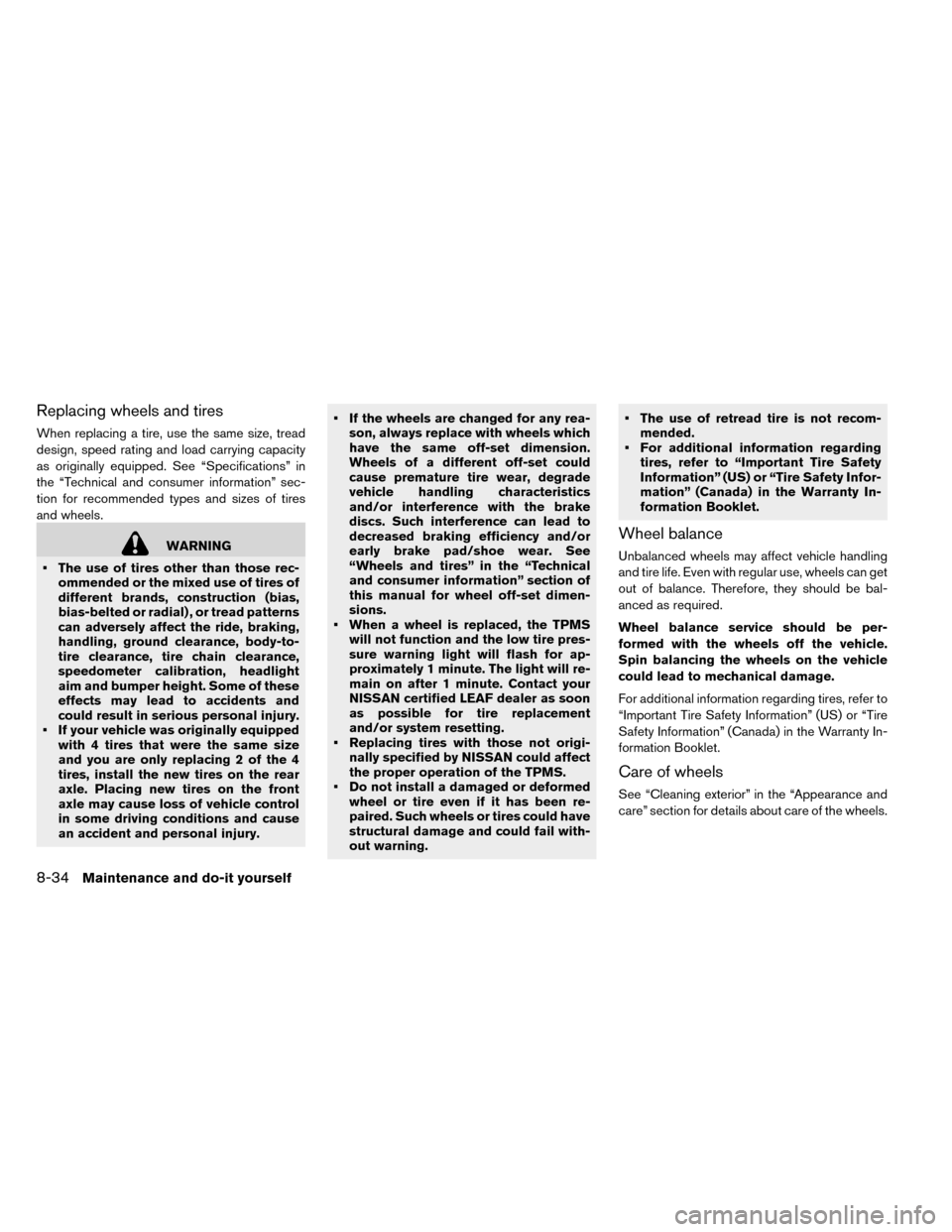
Replacing wheels and tires
When replacing a tire, use the same size, tread
design, speed rating and load carrying capacity
as originally equipped. See “Specifications” in
the “Technical and consumer information” sec-
tion for recommended types and sizes of tires
and wheels.
WARNING
• The use of tires other than those rec- ommended or the mixed use of tires of
different brands, construction (bias,
bias-belted or radial) , or tread patterns
can adversely affect the ride, braking,
handling, ground clearance, body-to-
tire clearance, tire chain clearance,
speedometer calibration, headlight
aim and bumper height. Some of these
effects may lead to accidents and
could result in serious personal injury.
• If your vehicle was originally equipped with 4 tires that were the same size
and you are only replacing 2 of the 4
tires, install the new tires on the rear
axle. Placing new tires on the front
axle may cause loss of vehicle control
in some driving conditions and cause
an accident and personal injury. • If the wheels are changed for any rea-
son, always replace with wheels which
have the same off-set dimension.
Wheels of a different off-set could
cause premature tire wear, degrade
vehicle handling characteristics
and/or interference with the brake
discs. Such interference can lead to
decreased braking efficiency and/or
early brake pad/shoe wear. See
“Wheels and tires” in the “Technical
and consumer information” section of
this manual for wheel off-set dimen-
sions.
• When a wheel is replaced, the TPMS will not function and the low tire pres-
sure warning light will flash for ap-
proximately 1 minute. The light will re-
main on after 1 minute. Contact your
NISSAN certified LEAF dealer as soon
as possible for tire replacement
and/or system resetting.
• Replacing tires with those not origi- nally specified by NISSAN could affect
the proper operation of the TPMS.
• Do not install a damaged or deformed wheel or tire even if it has been re-
paired. Such wheels or tires could have
structural damage and could fail with-
out warning. • The use of retread tire is not recom-
mended.
• For additional information regarding tires, refer to “Important Tire Safety
Information” (US) or “Tire Safety Infor-
mation” (Canada) in the Warranty In-
formation Booklet.Wheel balance
Unbalanced wheels may affect vehicle handling
and tire life. Even with regular use, wheels can get
out of balance. Therefore, they should be bal-
anced as required.
Wheel balance service should be per-
formed with the wheels off the vehicle.
Spin balancing the wheels on the vehicle
could lead to mechanical damage.
For additional information regarding tires, refer to
“Important Tire Safety Information” (US) or “Tire
Safety Information” (Canada) in the Warranty In-
formation Booklet.
Care of wheels
See “Cleaning exterior” in the “Appearance and
care” section for details about care of the wheels.
8-34Maintenance and do-it yourself
Page 374 of 412
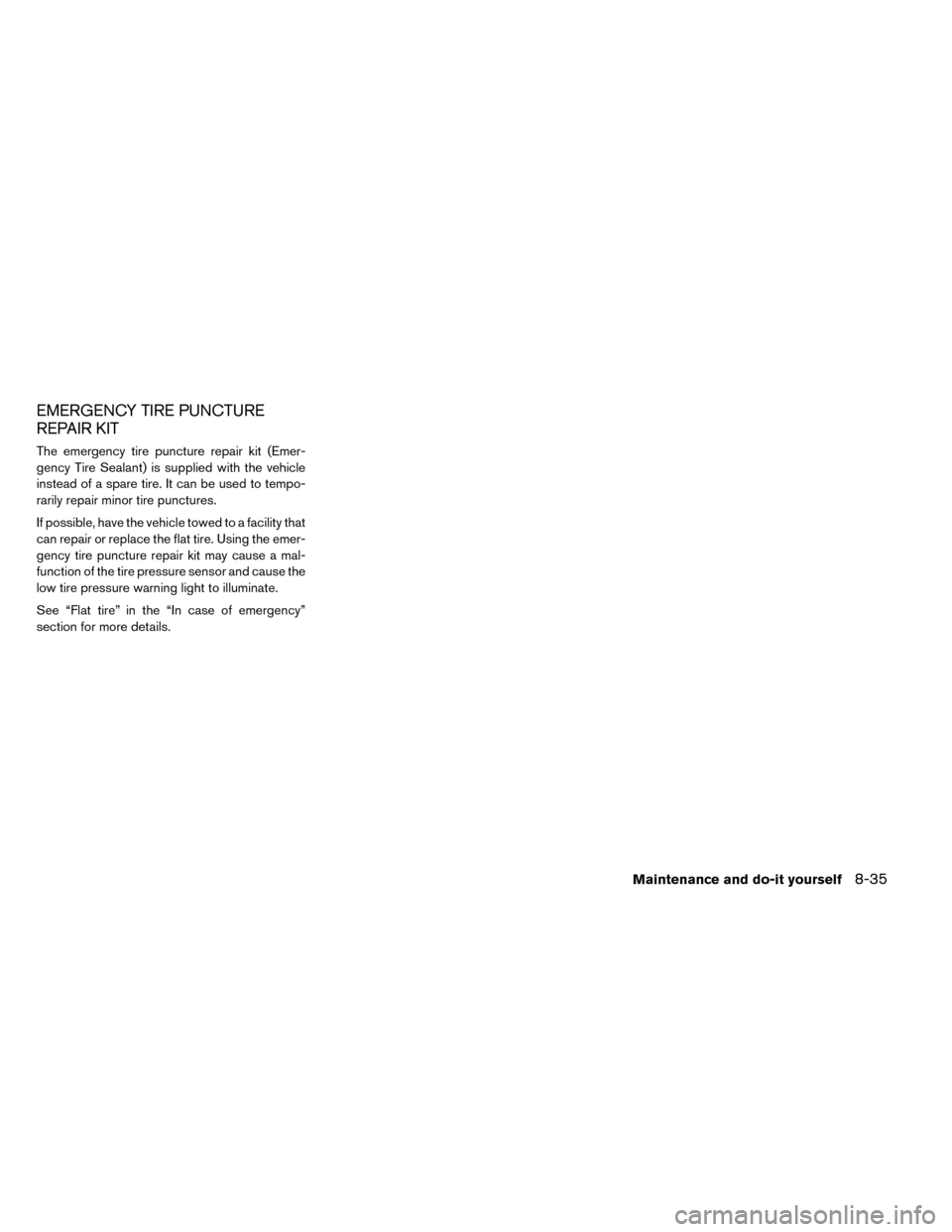
EMERGENCY TIRE PUNCTURE
REPAIR KIT
The emergency tire puncture repair kit (Emer-
gency Tire Sealant) is supplied with the vehicle
instead of a spare tire. It can be used to tempo-
rarily repair minor tire punctures.
If possible, have the vehicle towed to a facility that
can repair or replace the flat tire. Using the emer-
gency tire puncture repair kit may cause a mal-
function of the tire pressure sensor and cause the
low tire pressure warning light to illuminate.
See “Flat tire” in the “In case of emergency”
section for more details.
Maintenance and do-it yourself8-35
Page 398 of 412
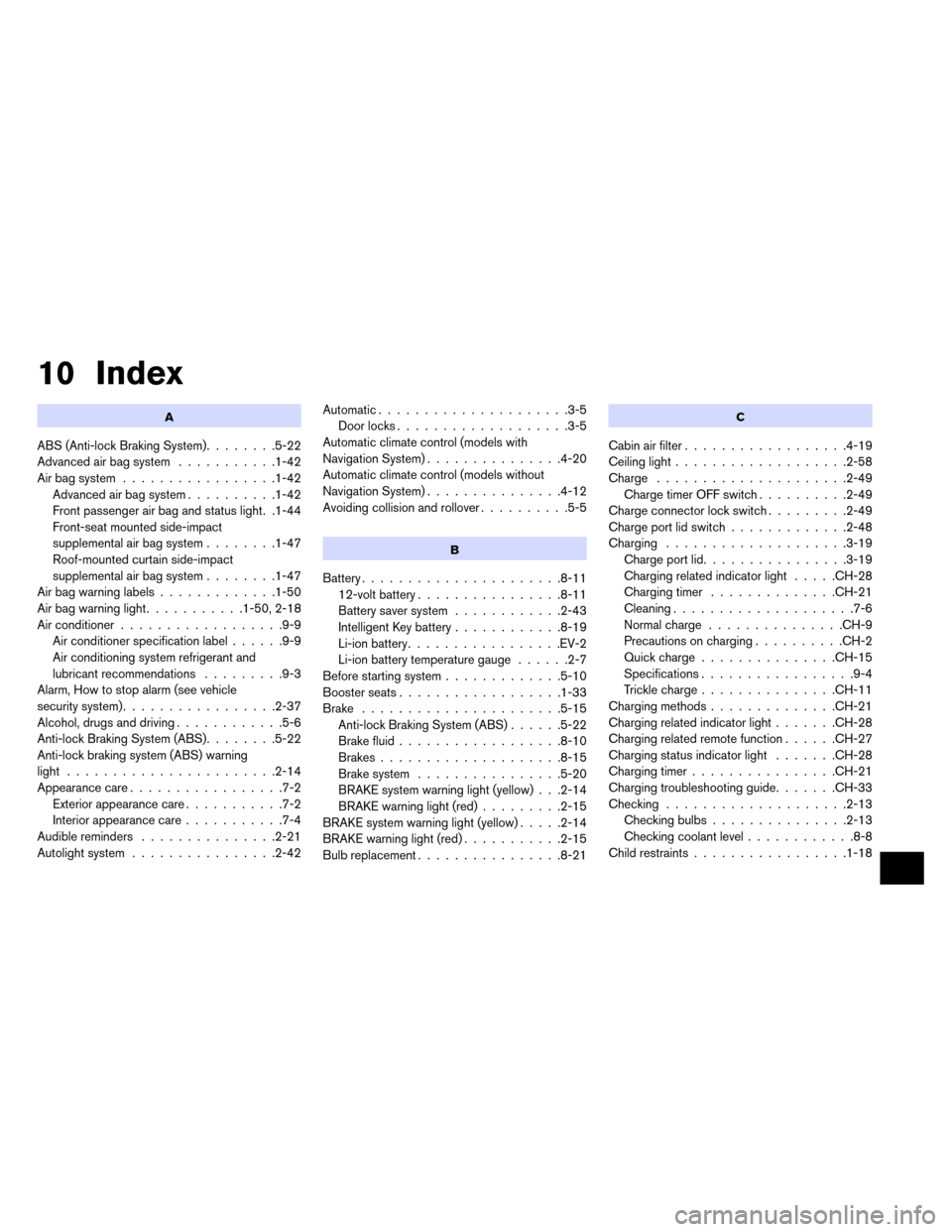
10 Index
A
ABS (Anti-lock Braking System)........5-22
Advanced air bag system ...........1-42
Air bag system .................1-42
Advanced air bag system ..........1-42
Front passenger air bag and status light. .1-44
Front-seat mounted side-impact
supplemental air bag system ........1-47
Roof-mounted curtain side-impact
supplemental air bag system ........1-47
Airbagwarninglabels.............1-50
Airbagwarninglight...........1-50,2-18
Air conditioner ..................9-9
Air conditioner specification label ......9-9
Air conditioning system refrigerant and
lubricant recommendations .........9-3
Alarm, How to stop alarm (see vehicle
security system) .................2-37
Alcohol, drugs and driving ............5-6
Anti-lock Braking System (ABS) ........5-22
Anti-lock braking system (ABS) warning
light .......................2-14
Appearance care .................7-2
Exterior appearance care ...........7-2
Interior appearance care ...........7-4
Audible reminders ...............2-21
Autolight system ................2-42 Automatic.....................3-5
Door locks ...................3-5
Automatic climate control (models with
Navigation System) ...............4-20
Automatic climate control (models without
Navigation System) ...............4-12
Avoiding collision and rollover ..........5-5
B
Battery......................8-11
12-volt battery ................8-11
Battery saver system ............2-43
Intelligent Key battery ............8-19
Li-ion battery .................EV-2
Li-ion battery temperature gauge ......2-7
Before starting system .............5-10
Boosterseats..................1-33
Brake ......................5-15 Anti-lock Braking System (ABS) ......5-22
Brakefluid..................8-10
Brakes....................8-15
Brake system ................5-20
BRAKE system warning light (yellow) . . .2-14
BRAKE warning light (red) .........2-15
BRAKE system warning light (yellow) .....2-14
BRAKE warning light (red) ...........2-15
Bulb replacement ................8-21
C
Cabin air filter..................4-19
Ceiling light ...................2-58
Charge .....................2-49
Charge timer OFF switch ..........2-49
Charge connector lock switch .........2-49
Charge port lid switch .............2-48
Charging ....................3-19
Chargeportlid................3-19
Charging related indicator light .....CH-28
Chargingtimer ..............CH-21
Cleaning ....................7-6
Normalcharge ...............CH-9
Precautions on charging ..........CH-2
Quickcharge...............CH-15
Specifications .................9-4
Trickle charge ...............CH-11
Charging methods ..............CH-21
Charging related indicator light .......CH-28
Charging related remote function ......CH-27
Charging status indicator light .......CH-28
Charging timer ................CH-21
Charging troubleshooting guide .......CH-33
Checking ....................2-13
Checkingbulbs...............2-13
Checking coolant level ............8-8
Child restraints .................1-18
Page 399 of 412
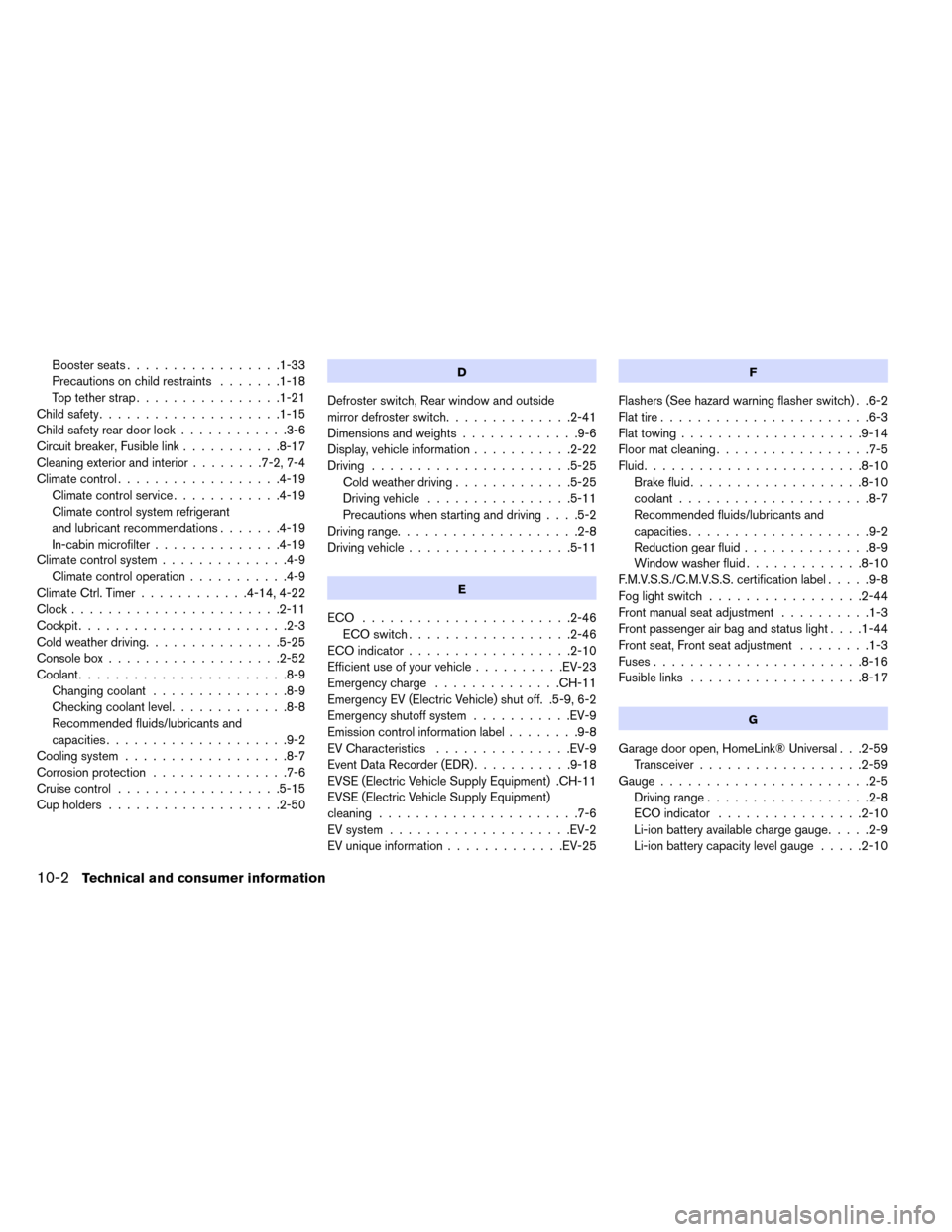
Boosterseats.................1-33
Precautions on child restraints.......1-18
Top tether strap ................1-21
Childsafety....................1-15
Child safety rear door lock ............3-6
Circuit breaker, Fusible link ...........8-17
Cleaning exterior and interior ........7-2,7-4
Climatecontrol..................4-19 Climate control service ............4-19
Climate control system refrigerant
and lubricant recommendations .......4-19
In-cabin microfilter ..............4-19
Climate control system ..............4-9
Climate control operation ...........4-9
Climate Ctrl. Timer ............4-14,4-22
Clock.......................2-11
Cockpit.......................2-3
Cold weather driving ...............5-25
Consolebox...................2-52
Coolant.......................8-9 Changingcoolant ...............8-9
Checkingcoolantlevel.............8-8
Recommended fluids/lubricants and
capacities ....................9-2
Cooling system ..................8-7
Corrosionprotection ...............7-6
Cruisecontrol..................5-15
Cupholders...................2-50D
Defroster switch, Rear window and outside
mirror defroster switch ..............2-41
Dimensionsandweights.............9-6
Display, vehicle information ...........2-22
Driving ......................5-25
Cold weather driving .............5-25
Driving vehicle ................5-11
Precautions when starting and driving ....5-2
Driving range ....................2-8
Driving vehicle ..................5-11
E
ECO .......................2-46
ECO switch ..................2-46
ECOindicator..................2-10
Efficient use of your vehicle ..........EV-23
Emergency charge ..............CH-11
Emergency EV (Electric Vehicle) shut off. .5-9, 6-2
Emergency shutoff system ...........EV-9
Emission control information label ........9-8
EV Characteristics ...............EV-9
Event Data Recorder (EDR) ...........9-18
EVSE (Electric Vehicle Supply Equipment) .CH-11
EVSE (Electric Vehicle Supply Equipment)
cleaning ......................7-6
EV system ....................EV-2
EV unique information .............EV-25
F
Flashers (See hazard warning flasher switch) . .6-2
Flat tire.......................6-3
Flattowing....................9-14
Floormatcleaning.................7-5
Fluid ........................8-10
Brake fluid ...................8-10
coolant.....................8-7
Recommended fluids/lubricants and
capacities ....................9-2
Reduction gear fluid ..............8-9
Window washer fluid .............8-10
F.M.V.S.S./C.M.V.S.S. certification label .....9-8
Foglightswitch .................2-44
Frontmanualseatadjustment ..........1-3
Front passenger air bag and status light ....1-44
Front seat, Front seat adjustment ........1-3
Fuses.......................8-16
Fusiblelinks ...................8-17
G
Garage door open, HomeLink® Universal . . .2-59 Transceiver ..................2-59
Gauge.......................2-5 Driving range ..................2-8
ECO indicator ................2-10
Li-ion battery available charge gauge .....2-9
Li-ion battery capacity level gauge .....2-10
10-2Technical and consumer information
Page 400 of 412
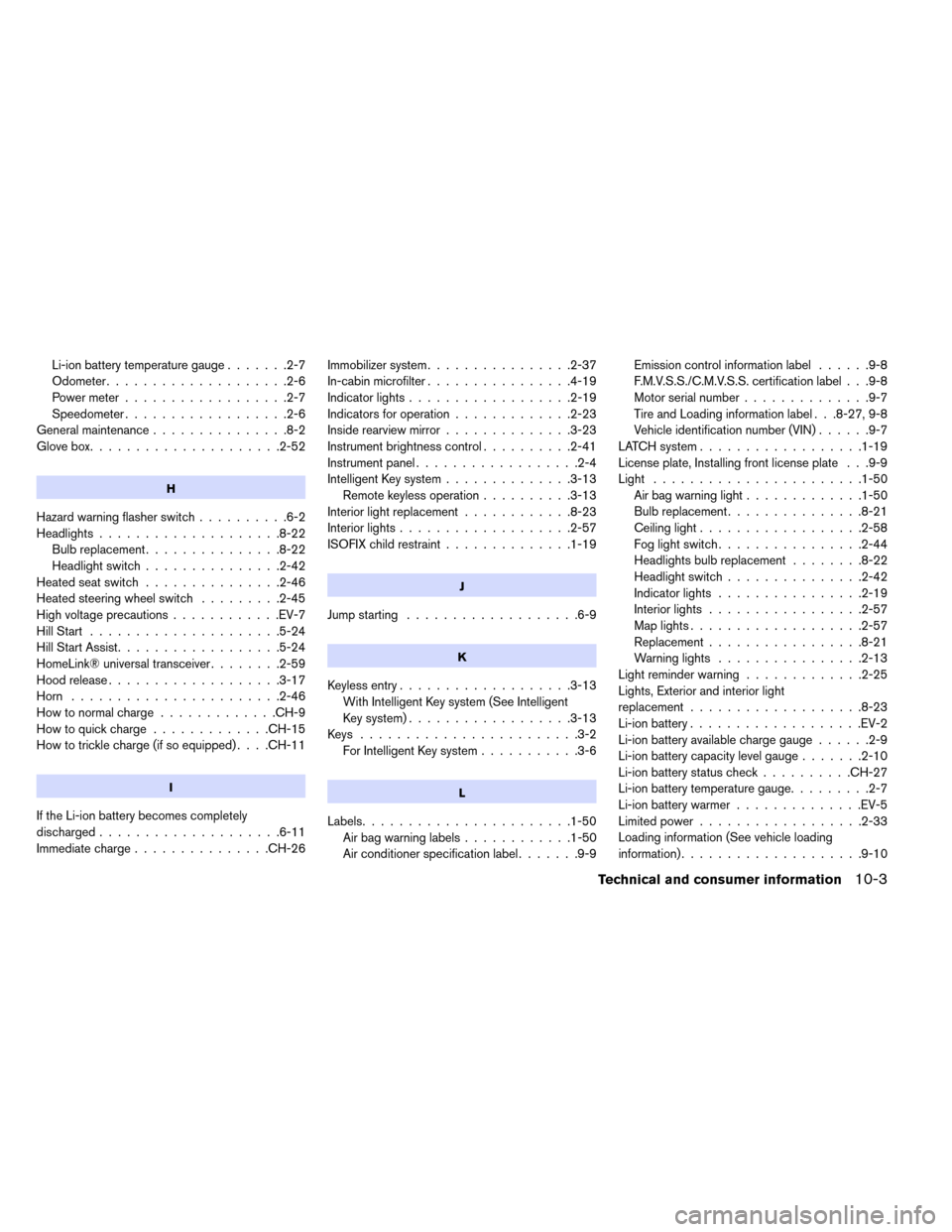
Li-ion battery temperature gauge.......2-7
Odometer ....................2-6
Power meter ..................2-7
Speedometer ..................2-6
Generalmaintenance...............8-2
Glovebox.....................2-52
H
Hazard warning flasher switch ..........6-2
Headlights ....................8-22
Bulb replacement ...............8-22
Headlightswitch...............2-42
Heatedseatswitch ...............2-46
Heated steering wheel switch .........2-45
High voltage precautions ............EV-7
HillStart .....................5-24
Hill Start Assist ..................5-24
HomeLink® universal transceiver ........2-59
Hood release ...................3-17
Horn .......................2-46
Howtonormalcharge.............CH-9
Howtoquickcharge.............CH-15
How to trickle charge (if so equipped) ....CH-11
I
If the Li-ion battery becomes completely
discharged....................6-11
Immediate charge...............CH-26 Immobilizer system
................2-37
In-cabin microfilter ................4-19
Indicatorlights..................2-19
Indicators for operation .............2-23
Inside rearview mirror ..............3-23
Instrument brightness control ..........2-41
Instrument panel ..................2-4
Intelligent Key system ..............3-13
Remote keyless operation ..........3-13
Interior light replacement ............8-23
Interior lights ...................2-57
ISOFIX child restraint ..............1-19
J
Jump starting...................6-9
K
Keylessentry...................3-13
With Intelligent Key system (See Intelligent
Key system) ..................3-13
Keys ........................3-2 For Intelligent Key system ...........3-6
L
Labels.......................1-50
Airbagwarninglabels............1-50
Air conditioner specification label .......9-9Emission control information label
......9-8
F.M.V.S.S./C.M.V.S.S. certification label . . .9-8
Motor serial number ..............9-7
Tire and Loading information label . . .8-27, 9-8
Vehicle identification number (VIN) ......9-7
LATCH system ..................1-19
License plate, Installing front license plate . . .9-9
Light .......................1-50 Airbagwarninglight.............1-50
Bulb replacement ...............8-21
Ceiling light ..................2-58
Fog light switch ................2-44
Headlightsbulbreplacement ........8-22
Headlightswitch...............2-42
Indicatorlights ................2-19
Interiorlights .................2-57
Maplights...................2-57
Replacement.................8-21
Warning lights ................2-13
Lightreminderwarning .............2-25
Lights, Exterior and interior light
replacement ...................8-23
Li-ion battery ...................EV-2
Li-ion battery available charge gauge ......2-9
Li-ion battery capacity level gauge .......2-10
Li-ion battery status check ..........CH-27
Li-ion battery temperature gauge .........2-7
Li-ion battery warmer ..............EV-5
Limited power ..................2-33
Loading information (See vehicle loading
information)....................9-10
Technical and consumer information10-3
Page 401 of 412
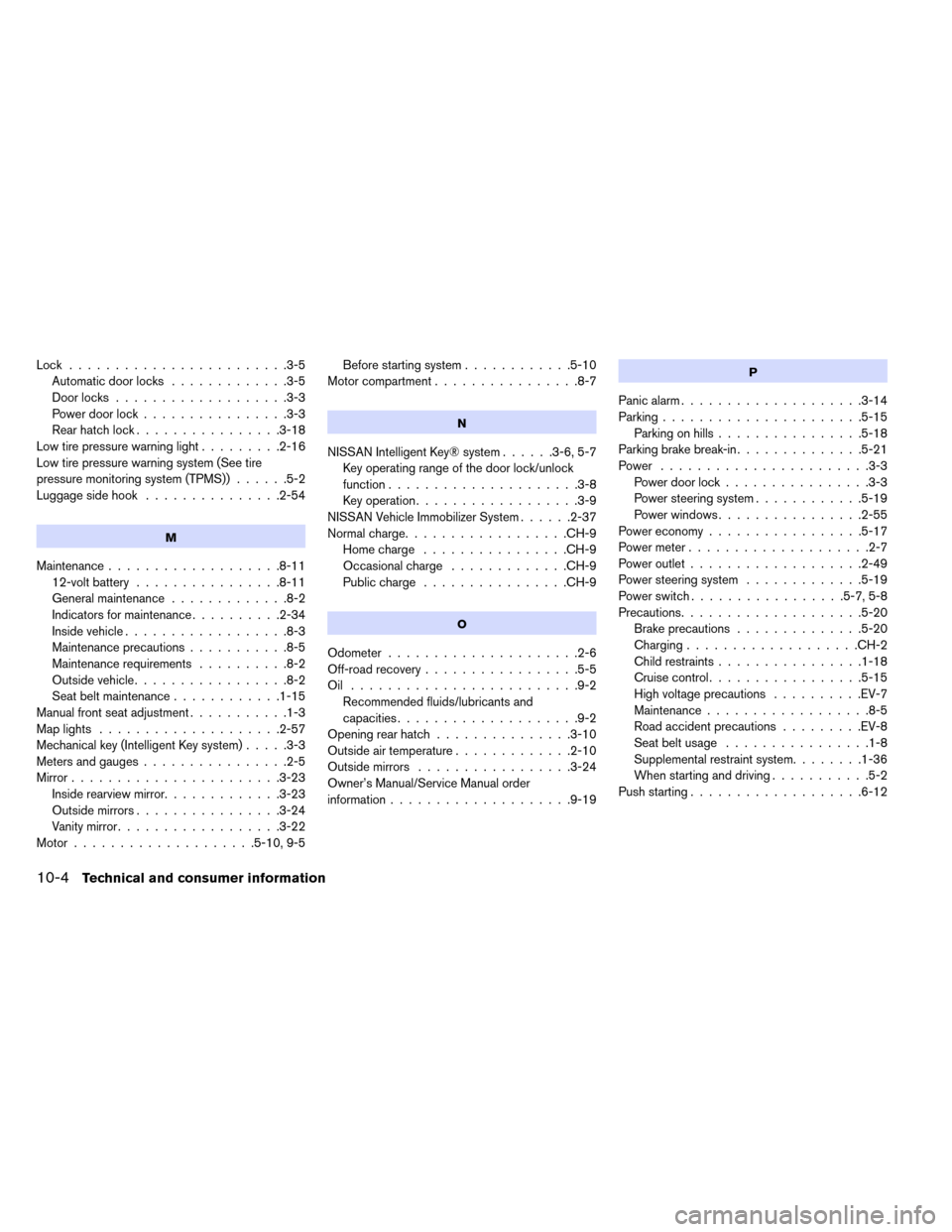
Lock........................3-5
Automatic door locks .............3-5
Door locks ...................3-3
Power door lock ................3-3
Rearhatchlock................3-18
Low tire pressure warning light .........2-16
Low tire pressure warning system (See tire
pressure monitoring system (TPMS)) ......5-2
Luggage side hook ...............2-54
M
Maintenance...................8-11
12-volt battery ................8-11
Generalmaintenance .............8-2
Indicatorsformaintenance..........2-34
Inside vehicle ..................8-3
Maintenance precautions ...........8-5
Maintenance requirements ..........8-2
Outside vehicle .................8-2
Seatbeltmaintenance............1-15
Manual front seat adjustment ...........1-3
Maplights ....................2-57
Mechanical key (Intelligent Key system) .....3-3
Meters and gauges ................2-5
Mirror .......................3-23
Inside rearview mirror.............3-23
Outside mirrors ................3-24
Vanity mirror ..................3-22
Motor....................5-10,9-5 Before starting system
............5-10
Motor compartment ................8-7
N
NISSAN Intelligent Key® system ......3-6,5-7
Key operating range of the door lock/unlock
function.....................3-8
Key operation ..................3-9
NISSAN Vehicle Immobilizer System ......2-37
Normalcharge..................CH-9 Home charge ................CH-9
Occasional charge .............CH-9
Publiccharge ................CH-9
O
Odometer .....................2-6
Off-road recovery .................5-5
Oil .........................9-2 Recommended fluids/lubricants and
capacities ....................9-2
Opening rear hatch ...............3-10
Outside air temperature .............2-10
Outside mirrors .................3-24
Owner’s Manual/Service Manual order
information ....................9-19
P
Panic alarm....................3-14
Parking ......................5-15
Parking on hills ................5-18
Parking brake break-in ..............5-21
Power .......................3-3 Power door lock ................3-3
Power steering system ............5-19
Power windows ................2-55
Powereconomy.................5-17
Powermeter....................2-7
Power outlet ...................2-49
Power steering system .............5-19
Powerswitch.................5-7,5-8
Precautions ....................5-20
Brake precautions ..............5-20
Charging ...................CH-2
Child restraints ................1-18
Cruise control .................5-15
High voltage precautions ..........EV-7
Maintenance..................8-5
Road accident precautions .........EV-8
Seatbeltusage ................1-8
Supplemental restraint system........1-36
When starting and driving ...........5-2
Push starting ...................6-12
10-4Technical and consumer information